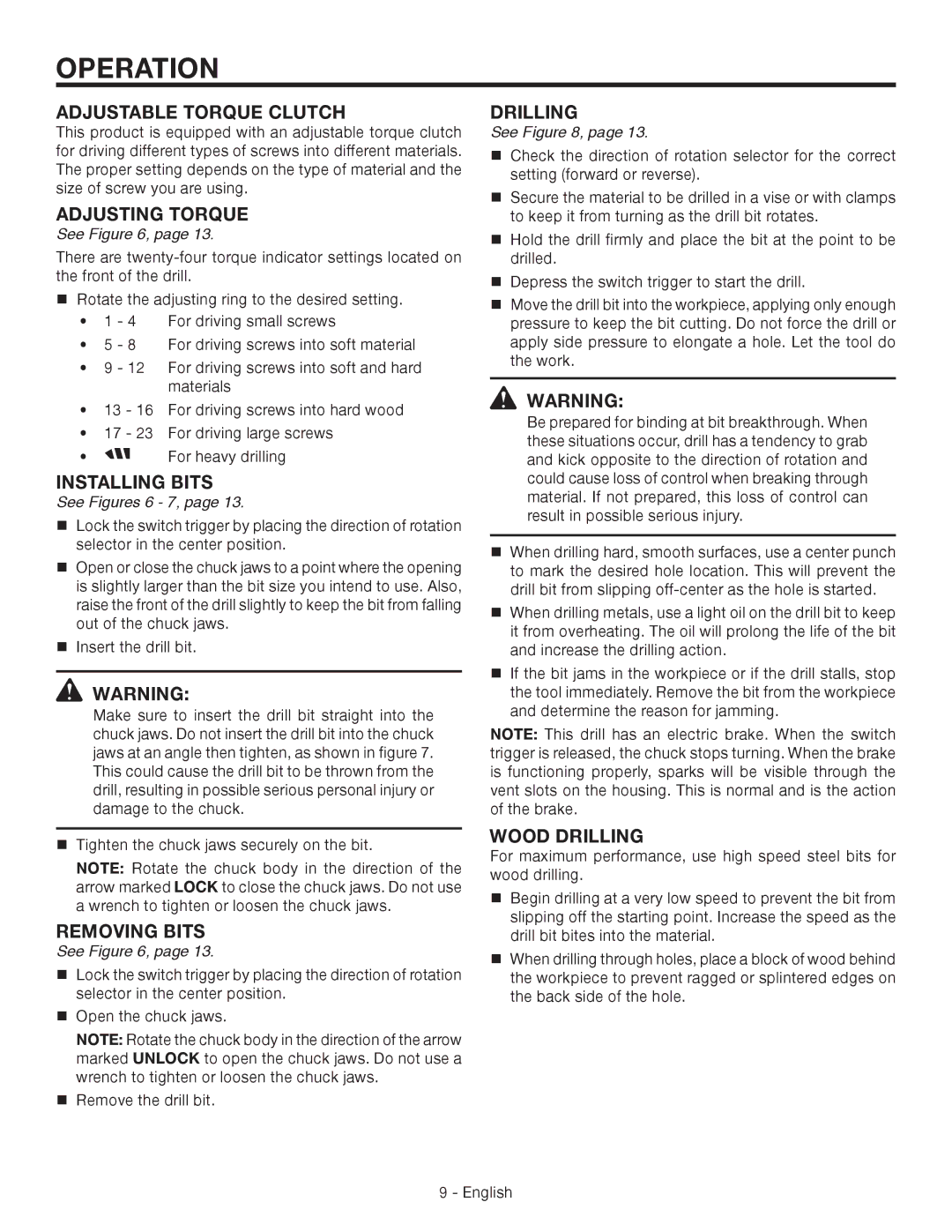
OPERATION
adjustable torque clutch
This product is equipped with an adjustable torque clutch for driving different types of screws into different materials. The proper setting depends on the type of material and the size of screw you are using.
ADJUSTing TORQUE
See Figure 6, page 13.
There are
Rotate the adjusting ring to the desired setting.
•1 - 4 For driving small screws
•5 - 8 For driving screws into soft material
•9 - 12 For driving screws into soft and hard materials
•13 - 16 For driving screws into hard wood
•17 - 23 For driving large screws
• | For heavy drilling |
INSTALLING BITS
See Figures 6 - 7, page 13.
Lock the switch trigger by placing the direction of rotation selector in the center position.
Open or close the chuck jaws to a point where the opening is slightly larger than the bit size you intend to use. Also, raise the front of the drill slightly to keep the bit from falling out of the chuck jaws.
Insert the drill bit.
![]() WARNING:
WARNING:
Make sure to insert the drill bit straight into the chuck jaws. Do not insert the drill bit into the chuck jaws at an angle then tighten, as shown in figure 7. This could cause the drill bit to be thrown from the drill, resulting in possible serious personal injury or damage to the chuck.
Tighten the chuck jaws securely on the bit.
Note: Rotate the chuck body in the direction of the arrow marked LOCK to close the chuck jaws. Do not use a wrench to tighten or loosen the chuck jaws.
REMOVING BITS
See Figure 6, page 13.
Lock the switch trigger by placing the direction of rotation selector in the center position.
Open the chuck jaws.
Note: Rotate the chuck body in the direction of the arrow marked UNLOCK to open the chuck jaws. Do not use a wrench to tighten or loosen the chuck jaws.
Remove the drill bit.
DRILLING
See Figure 8, page 13.
Check the direction of rotation selector for the correct setting (forward or reverse).
Secure the material to be drilled in a vise or with clamps to keep it from turning as the drill bit rotates.
Hold the drill firmly and place the bit at the point to be drilled.
Depress the switch trigger to start the drill.
Move the drill bit into the workpiece, applying only enough pressure to keep the bit cutting. Do not force the drill or apply side pressure to elongate a hole. Let the tool do the work.
![]() WARNING:
WARNING:
Be prepared for binding at bit breakthrough. When these situations occur, drill has a tendency to grab and kick opposite to the direction of rotation and could cause loss of control when breaking through material. If not prepared, this loss of control can result in possible serious injury.
When drilling hard, smooth surfaces, use a center punch to mark the desired hole location. This will prevent the drill bit from slipping
When drilling metals, use a light oil on the drill bit to keep it from overheating. The oil will prolong the life of the bit and increase the drilling action.
If the bit jams in the workpiece or if the drill stalls, stop the tool immediately. Remove the bit from the workpiece and determine the reason for jamming.
NOTE: This drill has an electric brake. When the switch trigger is released, the chuck stops turning. When the brake is functioning properly, sparks will be visible through the vent slots on the housing. This is normal and is the action of the brake.
WOOD DRILLING
For maximum performance, use high speed steel bits for wood drilling.
Begin drilling at a very low speed to prevent the bit from slipping off the starting point. Increase the speed as the drill bit bites into the material.
When drilling through holes, place a block of wood behind the workpiece to prevent ragged or splintered edges on the back side of the hole.
9 - English
